The Cambridge History of Japan, Vol. 4: Early Modern Japan
Подождите немного. Документ загружается.

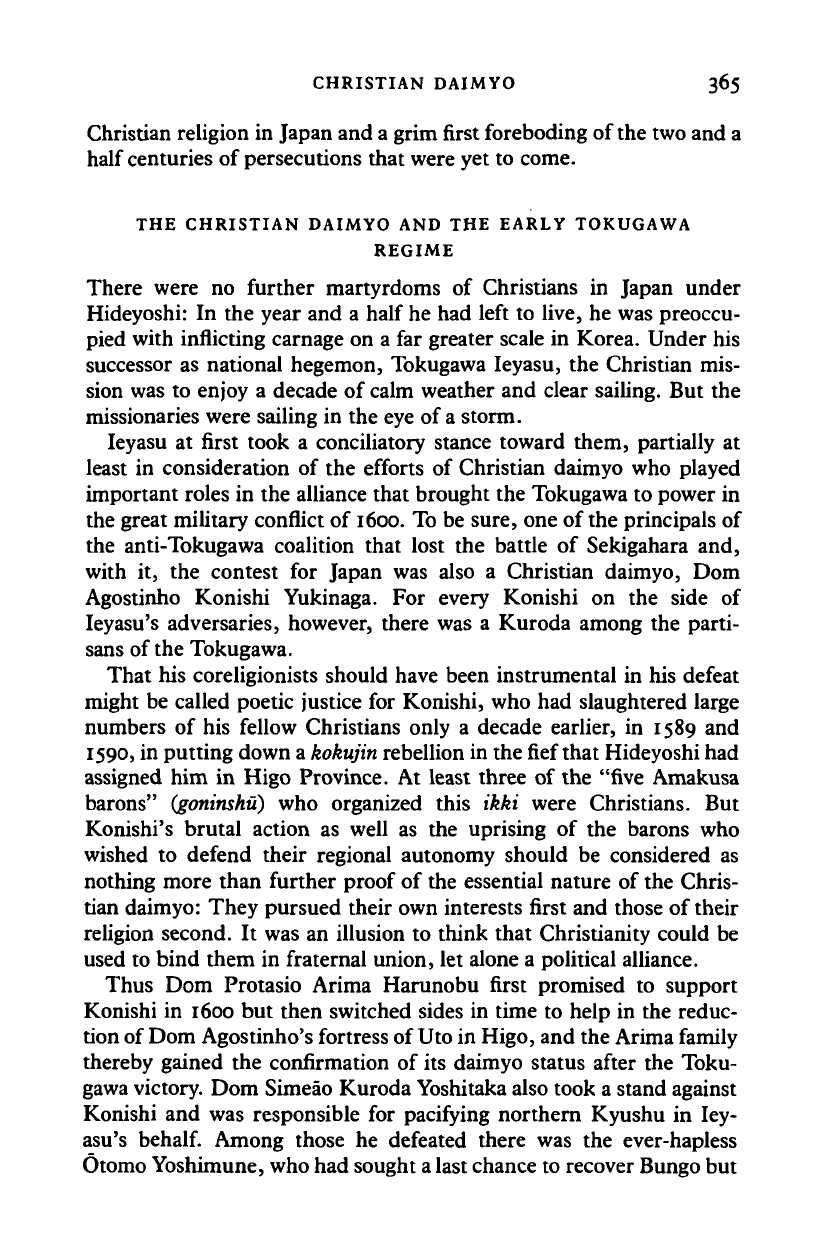
CHRISTIAN DAIMYO 365
Christian religion in Japan and a grim first foreboding of the two and a
half centuries of persecutions that were yet to come.
THE CHRISTIAN DAIMYO AND THE EARLY TOKUGAWA
REGIME
There were no further martyrdoms of Christians in Japan under
Hideyoshi: In the year and a half he had left to live, he was preoccu-
pied with inflicting carnage on a far greater scale in Korea. Under his
successor as national hegemon, Tokugawa Ieyasu, the Christian mis-
sion was to enjoy a decade of calm weather and clear sailing. But the
missionaries were sailing in the eye of
a
storm.
Ieyasu at first took a conciliatory stance toward them, partially at
least in consideration of the efforts of Christian daimyo who played
important roles in the alliance that brought the Tokugawa to power in
the great military conflict of
1600.
To be sure, one of the principals of
the anti-Tokugawa coalition that lost the battle of Sekigahara and,
with it, the contest for Japan was also a Christian daimyo, Dom
Agostinho Konishi Yukinaga. For every Konishi on the side of
Ieyasu's adversaries, however, there was a Kuroda among the parti-
sans of the Tokugawa.
That his coreligionists should have been instrumental in his defeat
might be called poetic justice for Konishi, who had slaughtered large
numbers of his fellow Christians only a decade earlier, in 1589 and
1590,
in putting down a
kokujin
rebellion in the
fief
that Hideyoshi had
assigned him in Higo Province. At least three of the "five Amakusa
barons" (goninshu) who organized this ikki were Christians. But
Konishi's brutal action as well as the uprising of the barons who
wished to defend their regional autonomy should be considered as
nothing more than further proof of the essential nature of the Chris-
tian daimyo: They pursued their own interests first and those of their
religion second. It was an illusion to think that Christianity could be
used to bind them in fraternal union, let alone a political alliance.
Thus Dom Protasio Arima Harunobu first promised to support
Konishi in 1600 but then switched sides in time to help in the reduc-
tion of Dom Agostinho's fortress of
Uto
in Higo, and the Arima family
thereby gained the confirmation of its daimyo status after the Toku-
gawa victory. Dom Simeao Kuroda Yoshitaka also took a stand against
Konishi and was responsible for pacifying northern Kyushu in Iey-
asu's
behalf.
Among those he defeated there was the ever-hapless
Otomo Yoshimune, who had sought
a
last chance to recover Bungo but
Cambridge Histories Online © Cambridge University Press, 2008
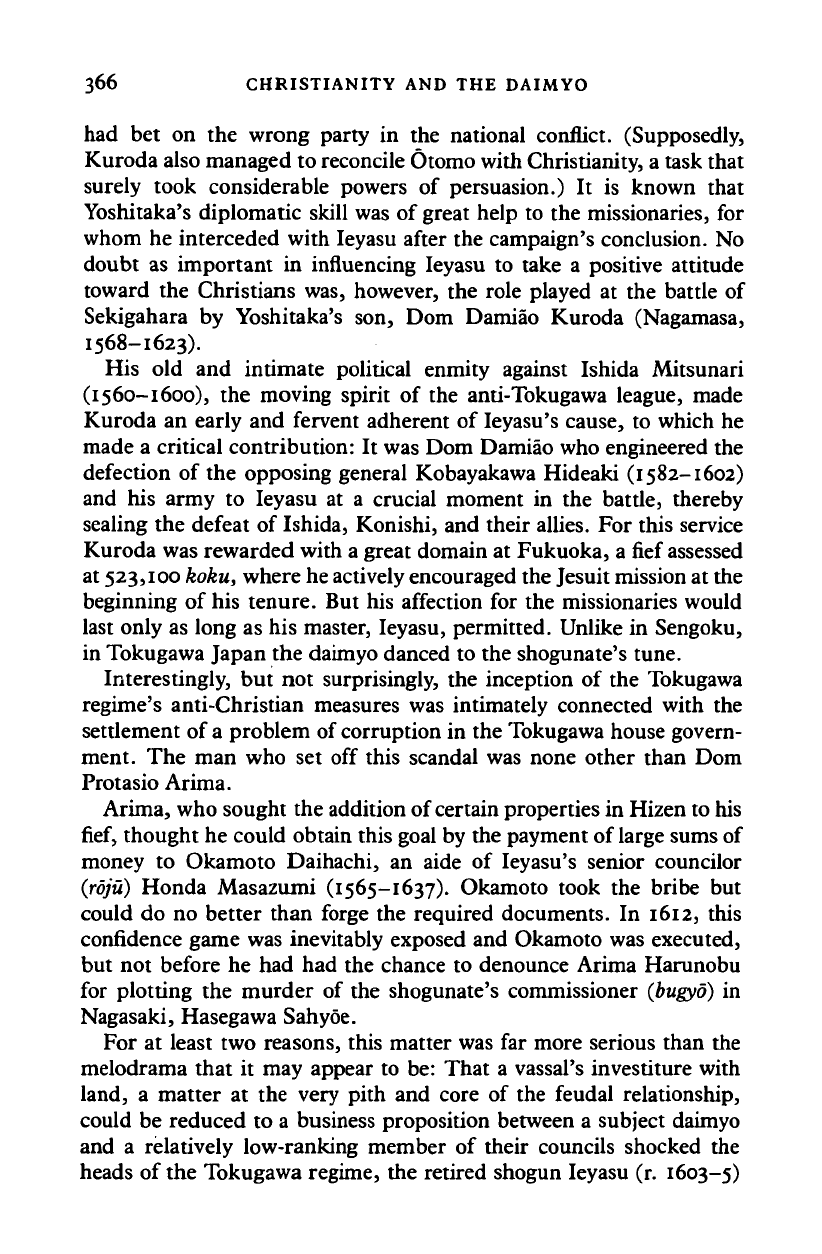
366 CHRISTIANITY AND THE DAIMYO
had bet on the wrong party in the national conflict. (Supposedly,
Kuroda also managed to reconcile Otomo with Christianity, a task that
surely took considerable powers of persuasion.) It is known that
Yoshitaka's diplomatic skill was of great help to the missionaries, for
whom he interceded with Ieyasu after the campaign's conclusion. No
doubt as important in influencing Ieyasu to take a positive attitude
toward the Christians was, however, the role played at the battle of
Sekigahara by Yoshitaka's son, Dom Damiao Kuroda (Nagamasa,
1568-1623).
His old and intimate political enmity against Ishida Mitsunari
(1560-1600), the moving spirit of the anti-Tokugawa league, made
Kuroda an early and fervent adherent of Ieyasu's cause, to which he
made a critical contribution: It was Dom Damiao who engineered the
defection of the opposing general Kobayakawa Hideaki (1582-1602)
and his army to Ieyasu at a crucial moment in the battle, thereby
sealing the defeat of Ishida, Konishi, and their allies. For this service
Kuroda was rewarded with a great domain at Fukuoka, a fief assessed
at 523,100 koku, where he actively encouraged the Jesuit mission at the
beginning of his tenure. But his affection for the missionaries would
last only as long as his master, Ieyasu, permitted. Unlike in Sengoku,
in Tokugawa Japan the daimyo danced to the shogunate's tune.
Interestingly, but not surprisingly, the inception of the Tokugawa
regime's anti-Christian measures was intimately connected with the
settlement of
a
problem of corruption in the Tokugawa house govern-
ment. The man who set off this scandal was none other than Dom
Protasio Arima.
Arima, who sought the addition of certain properties in Hizen to his
fief,
thought he could obtain this goal by the payment of
large
sums of
money to Okamoto Daihachi, an aide of Ieyasu's senior councilor
(rcj/'w) Honda Masazumi (1565-1637). Okamoto took the bribe but
could do no better than forge the required documents. In 1612, this
confidence game was inevitably exposed and Okamoto was executed,
but not before he had had the chance to denounce Arima Harunobu
for plotting the murder of the shogunate's commissioner
(bugyo)
in
Nagasaki, Hasegawa Sahyoe.
For at least two reasons, this matter was far more serious than the
melodrama that it may appear to be: That a vassal's investiture with
land, a matter at the very pith and core of the feudal relationship,
could be reduced to a business proposition between a subject daimyo
and a relatively low-ranking member of their councils shocked the
heads of the Tokugawa regime, the retired shogun Ieyasu (r. 1603-5)
Cambridge Histories Online © Cambridge University Press, 2008

CHRISTIAN DAIMYO 367
and his successor Hidetada (1579-1632, r. 1605-23). And the allega-
tion that the magistrate charged with the government of one of the
shogunate's most important direct holdings, the port city of Nagasaki,
had become the object of an assassination plot raised broader ques-
tions regarding the loyalty of the western daimyo.
75
It did not help
matters that both the principals in this nasty business, Protasio Arima
and Paulo Okamoto, were Christians.
For his part in the Okamoto Daihachi incident, Dom Protasio
Arima was first exiled from his province and then sentenced to death.
But the incident had far broader consequences than the punishment of
this one daimyo. The Tokugawa turned against Christianity with a
vengeance, prohibiting the religion in shogunal domains. Needless to
say, this measure was imitated by their subjects, the domanial rulers.
One of the first who sought to ingratiate themselves with the Toku-
gawa that way was Harunobu's son, Dom Miguel Arima (Naozumi,
1586-1641), who apostatized, was installed by the shogunate as
daimyo in Arima, and immediately began a massive effort to force his
Catholic subjects into abandoning their faith. Not successful enough
in that effort to please his masters, he was in 1614 transferred to
another
fief,
Nobeoka in Hyuga. He left behind him
a
restive Christian
populace and the seedbed of the Shimabara Rebellion, a large-scale
disturbance that broke out in 1637 and confirmed the Edo bakufu in
its cherished conviction that Christianity was a subversive faith.
The basic rationale for that judgment was laid out on February 1,
1614 (Keicho 18.12.23), f°
r
the rest of the Tokugawa era in a docu-
ment that had the force of an ancestral law, because it was written at
the behest of the founding father, Ieyasu. This "Statement on the
Expulsion of the Bateren," which was drafted by the Zen monk
Konchiin Suden (1563-1633), first rehearses the standard traditional-
ist dictum, "Japan is the Land of the Gods," and then declares that the
Christians seek to make Japan into "their own possession." Their
religion teaches them to "contravene governmental regulations, tra-
duce Shinto, calumniate the True Law, destroy righteousness, corrupt
goodness" - in short, to subvert the native Japanese, the Buddhist,
and the Confucian foundations of the social order. What else was this
if not
jaho,
the ultimate "pernicious doctrine?"
76
75 See Shimizu Hirokazu, Kirishilan kinseishi, vol. 109 of Kyoikusha rekishi
shinsko:
Nihonshi
(Tokyo: Kyoikusha, 1981), pp. 98-101.
76 The original text can be found conveniently in Okubo Toshiaki, Kodama Kota, Yanai Kenji,
and Inoue Mitsusada, eds., Shiryo ni yom Nihon no ayumi (kinsei) (Tokyo: Yoshikawa
kobunkan, 1963), pp. 124-5.
Cambridge Histories Online © Cambridge University Press, 2008
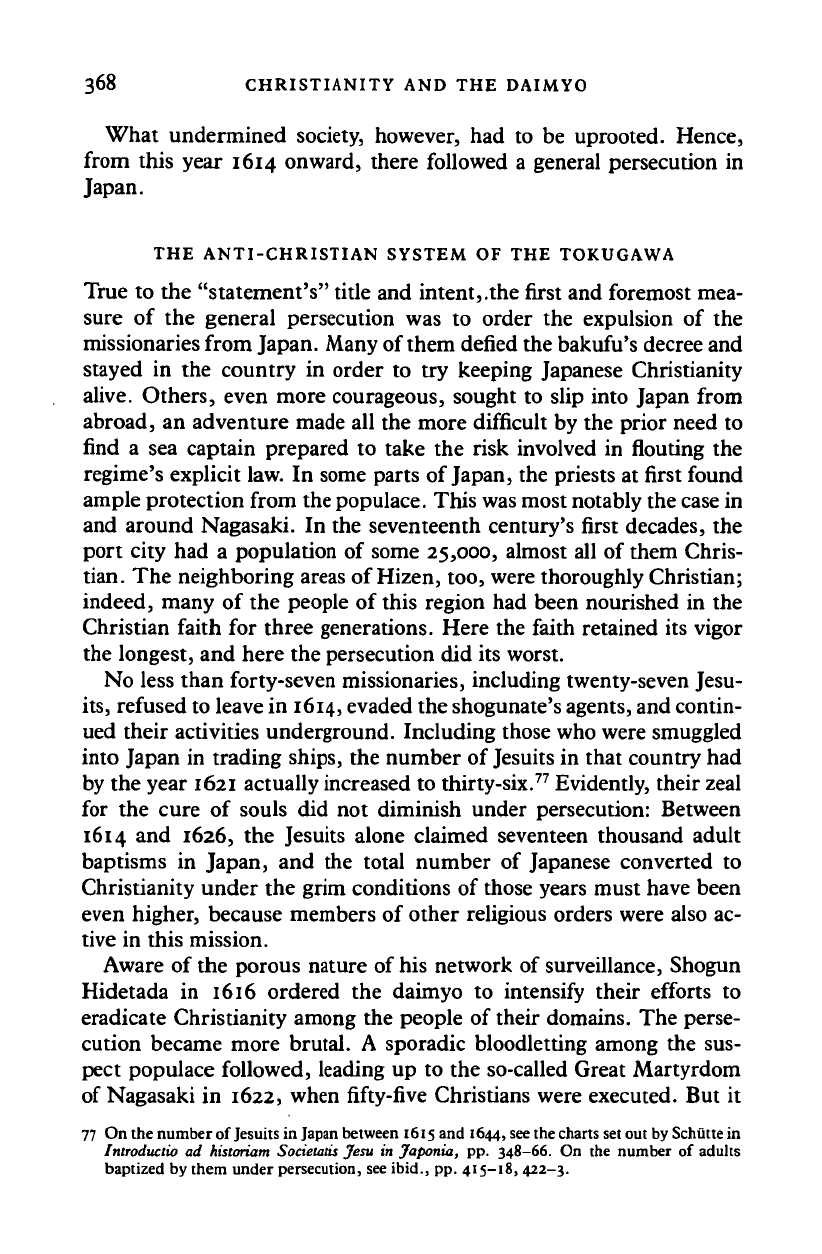
368 CHRISTIANITY AND THE DAIMYO
What undermined society, however, had to be uprooted. Hence,
from this year 1614 onward, there followed a general persecution in
Japan.
THE ANTI-CHRISTIAN SYSTEM OF THE TOKUGAWA
True to the "statement's" title and intent,.the first and foremost mea-
sure of the general persecution was to order the expulsion of the
missionaries from Japan. Many of them defied the bakufu's decree and
stayed in the country in order to try keeping Japanese Christianity
alive. Others, even more courageous, sought to slip into Japan from
abroad, an adventure made all the more difficult by the prior need to
find a sea captain prepared to take the risk involved in flouting the
regime's explicit law. In some parts of Japan, the priests at first found
ample protection from the
populace.
This was most notably the case in
and around Nagasaki. In the seventeenth century's first decades, the
port city had a population of some 25,000, almost all of them Chris-
tian. The neighboring areas of Hizen, too, were thoroughly Christian;
indeed, many of the people of this region had been nourished in the
Christian faith for three generations. Here the faith retained its vigor
the longest, and here the persecution did its worst.
No less than forty-seven missionaries, including twenty-seven Jesu-
its,
refused to leave in
1614,
evaded the shogunate's agents, and contin-
ued their activities underground. Including those who were smuggled
into Japan in trading ships, the number of Jesuits in that country had
by the year 1621 actually increased to thirty-six.
77
Evidently, their zeal
for the cure of souls did not diminish under persecution: Between
1614 and 1626, the Jesuits alone claimed seventeen thousand adult
baptisms in Japan, and the total number of Japanese converted to
Christianity under the grim conditions of those years must have been
even higher, because members of other religious orders were also ac-
tive in this mission.
Aware of the porous nature of his network of surveillance, Shogun
Hidetada in 1616 ordered the daimyo to intensify their efforts to
eradicate Christianity among the people of their domains. The perse-
cution became more brutal. A sporadic bloodletting among the sus-
pect populace followed, leading up to the so-called Great Martyrdom
of Nagasaki in 1622, when fifty-five Christians were executed. But it
77 On the number of Jesuits in Japan between 1615 and 1644, see the charts set out by Schutte in
Intwductio ad hislonam Societatis Jesu in Japonia, pp. 348-66. On the number of adults
baptized by them under persecution, see ibid., pp. 415-18, 422-3.
Cambridge Histories Online © Cambridge University Press, 2008
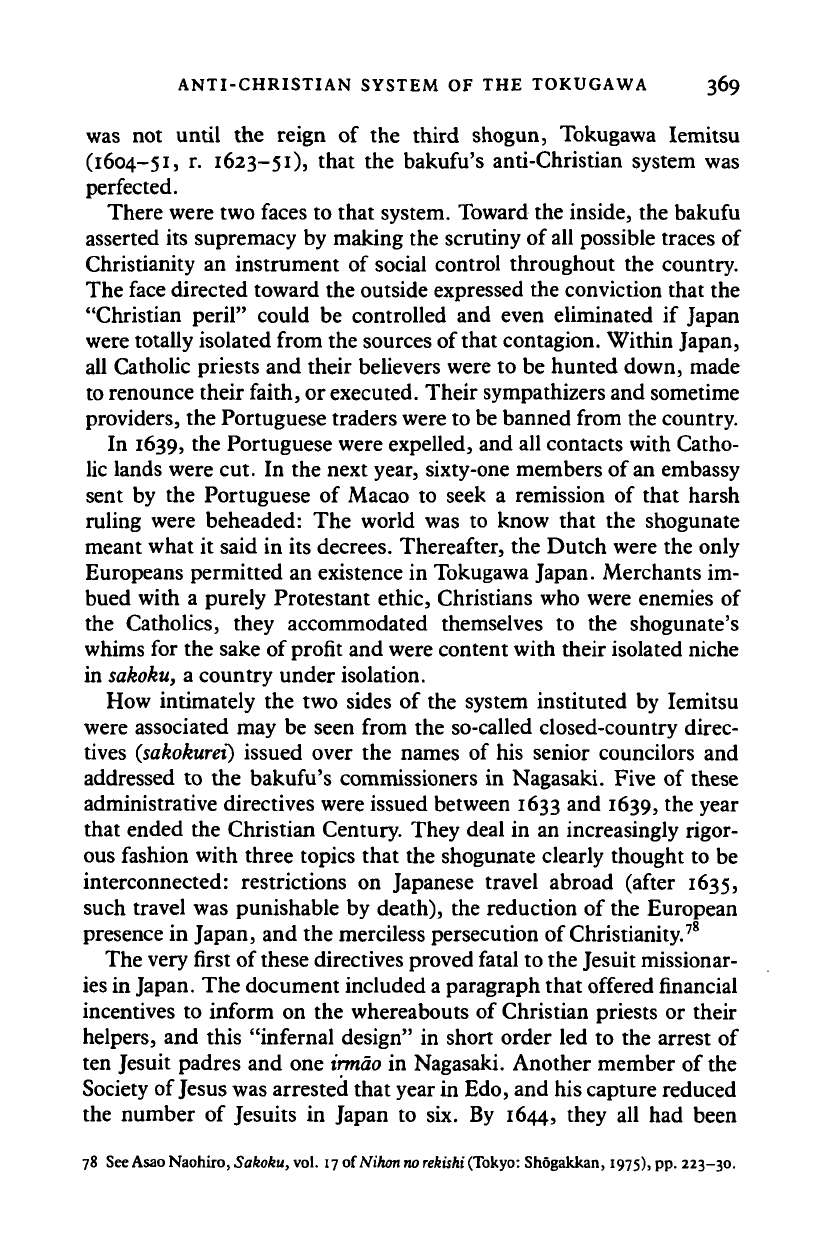
ANTI-CHRISTIAN SYSTEM OF THE TOKUGAWA 369
was not until the reign of the third shogun, Tokugawa Iemitsu
(1604-51,
r. 1623-51), that the bakufu's anti-Christian system was
perfected.
There were two faces to that system. Toward the inside, the bakufu
asserted its supremacy by making the scrutiny of
all
possible traces of
Christianity an instrument of social control throughout the country.
The face directed toward the outside expressed the conviction that the
"Christian peril" could be controlled and even eliminated if Japan
were totally isolated from the sources of that contagion. Within Japan,
all Catholic priests and their believers were to be hunted down, made
to renounce their faith, or executed. Their sympathizers and sometime
providers, the Portuguese traders were to be banned from the country.
In 1639, the Portuguese were expelled, and all contacts with Catho-
lic lands were cut. In the next year, sixty-one members of an embassy
sent by the Portuguese of Macao to seek a remission of that harsh
ruling were beheaded: The world was to know that the shogunate
meant what it said in its decrees. Thereafter, the Dutch were the only
Europeans permitted an existence in Tokugawa Japan. Merchants im-
bued with a purely Protestant ethic, Christians who were enemies of
the Catholics, they accommodated themselves to the shogunate's
whims for the sake of profit and were content with their isolated niche
in
sakoku,
a country under isolation.
How intimately the two sides of the system instituted by Iemitsu
were associated may be seen from the so-called closed-country direc-
tives
(sakokuret)
issued over the names of his senior councilors and
addressed to the bakufu's commissioners in Nagasaki. Five of these
administrative directives were issued between 1633 and 1639, the year
that ended the Christian Century. They deal in an increasingly rigor-
ous fashion with three topics that the shogunate clearly thought to be
interconnected: restrictions on Japanese travel abroad (after 1635,
such travel was punishable by death), the reduction of the European
presence in Japan, and the merciless persecution of Christianity.
78
The very first of these directives proved fatal to the Jesuit missionar-
ies in Japan. The document included a paragraph that offered financial
incentives to inform on the whereabouts of Christian priests or their
helpers, and this "infernal design" in short order led to the arrest of
ten Jesuit padres and one
irmdo
in Nagasaki. Another member of the
Society of Jesus was arrested that year in Edo, and his capture reduced
the number of Jesuits in Japan to six. By 1644, they all had been
78 See Asao Naohiro, Sakoku, vol. 17 of Nikon
no rekishi
(Tokyo:
Shogakkan, 1975), pp. 223-30.
Cambridge Histories Online © Cambridge University Press, 2008
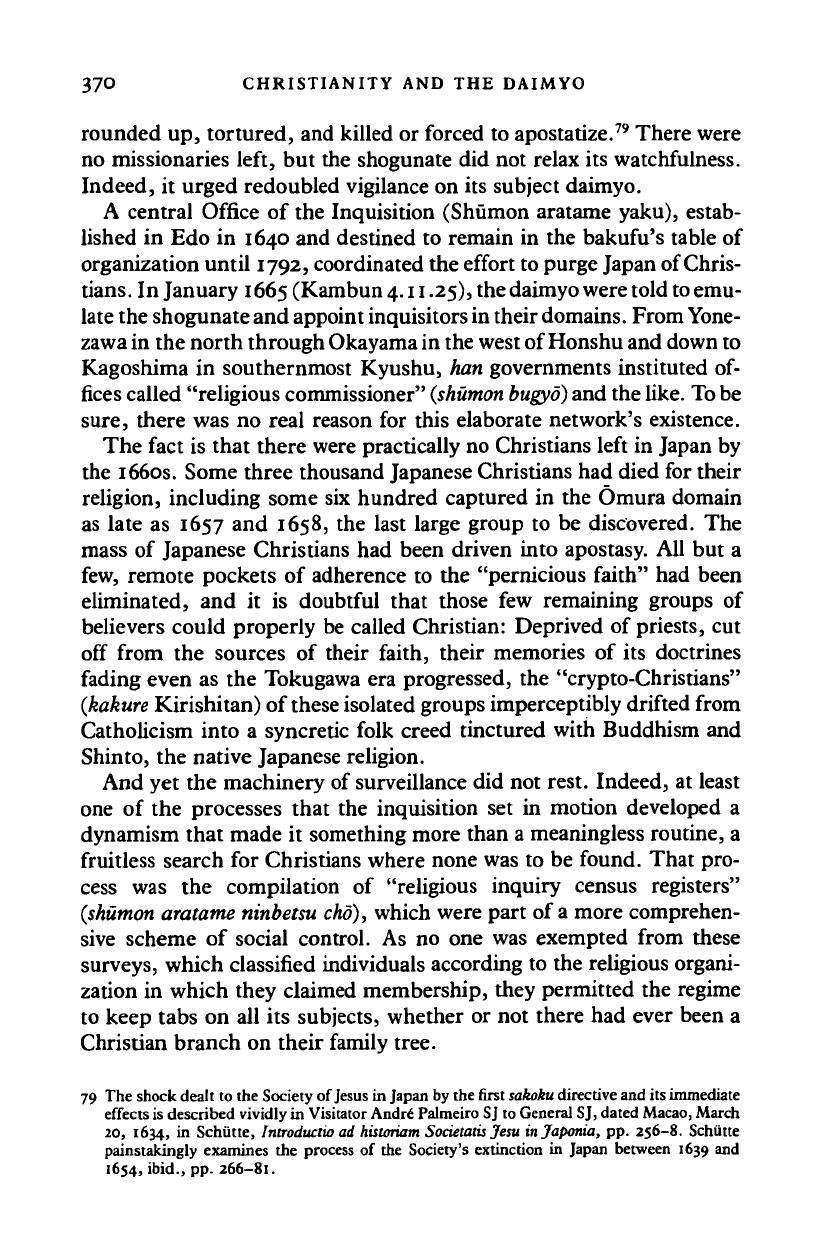
37° CHRISTIANITY AND THE DAIMYO
rounded up, tortured, and killed or forced to apostatize.
79
There were
no missionaries left, but the shogunate did not relax its watchfulness.
Indeed, it urged redoubled vigilance on its subject daimyo.
A central Office of the Inquisition (Shumon aratame yaku), estab-
lished in Edo in 1640 and destined to remain in the bakufu's table of
organization until 1792, coordinated the effort to purge Japan of
Chris-
tians.
In January 1665 (Kambun
4.11.25),
the
daimyo
were
told
to
emu-
late the shogunate and appoint inquisitors in their domains. From
Yone-
zawa in the north through Okayama in the west of Honshu and down to
Kagoshima in southernmost Kyushu, han governments instituted of-
fices called "religious commissioner"
{shumon bugyo)
and the
like.
To
be
sure,
there was no real reason for this elaborate network's existence.
The fact is that there were practically no Christians left in Japan by
the 1660s. Some three thousand Japanese Christians had died for their
religion, including some six hundred captured in the Omura domain
as late as 1657 and 1658, the last large group to be discovered. The
mass of Japanese Christians had been driven into apostasy. All but a
few, remote pockets of adherence to the "pernicious faith" had been
eliminated, and it is doubtful that those few remaining groups of
believers could properly be called Christian: Deprived of priests, cut
off from the sources of their faith, their memories of its doctrines
fading even as the Tokugawa era progressed, the "crypto-Christians"
(kakure
Kirishitan) of these isolated groups imperceptibly drifted from
Catholicism into a syncretic folk creed tinctured with Buddhism and
Shinto, the native Japanese religion.
And yet the machinery of surveillance did not rest. Indeed, at least
one of the processes that the inquisition set in motion developed a
dynamism that made it something more than a meaningless routine, a
fruitless search for Christians where none was to be found. That pro-
cess was the compilation of "religious inquiry census registers"
(shumon aratame ninbetsu
cho),
which were part of
a
more comprehen-
sive scheme of social control. As no one was exempted from these
surveys, which classified individuals according to the religious organi-
zation in which they claimed membership, they permitted the regime
to keep tabs on all its subjects, whether or not there had ever been a
Christian branch on their family tree.
79 The shock dealt to the Society of Jesus in Japan by the first
sakoku
directive and its immediate
effects is described vividly in Visitator Andre Palmeiro SJ to General SJ, dated Macao, March
20,
1634, in Schutte,
Invroductio
ad
historiam Societatis
Jesu injaponia, pp. 256-8. Schutte
painstakingly examines the process of the Society's extinction in Japan between 1639 and
1654,
ibid., pp. 266-81.
Cambridge Histories Online © Cambridge University Press, 2008

ANTI-CHRISTIAN SYSTEM OF THE TOKUGAWA 371
The Buddhist ecclesiastical establishment was made responsible for
verifying that a person was not a Christian through what became
known as the "temple guarantee system"
(terauke
seido).
By the 1630s,
people were being required to produce a certificate of affiliation with a
Buddhist temple as a proof of religious orthodoxy, social acceptability,
and loyalty to the regime. In the Obama domain of Wakasa Province,
for example, the daimyo Sakai Tadakatsu (1587-1662), a senior coun-
cilor of the shogunate, decreed peremptorily: "Everyone must have a
[Buddhist] temple to go to for proof that he or she is not a Christian.
Temple priests will therefore be required to issue guarantees." In
1639,
newcomers who wanted to buy or rent houses in the city of
Osaka were required to produce a temple's attestation before the con-
tract could be signed. By the 1670s, such guarantees were required of
anyone wishing to enter any type of service.
80
When this system matured at the beginning of the eighteenth cen-
tury, all members of the population were enrolled at birth in the Bud-
dhist temple with which their family was affiliated and were listed as
parishioners in the temple's
shumon aratame ninbetsu
cho.
The temple
was responsible for keeping these registers up-to-date and for forward-
ing
them periodically through the local officials to the domanial lord. So
rigorously enforced was the
terauke
requirement that in many portions
of Japan these documents provide modern demographers with exten-
sive
and reliable population
data.
Surely
this is an
effect that the inquisi-
tors neither intended nor foresaw.
What does the sum total of
the
shogunate's policies amount to? The
Edo bakufu seized control of the country's relations with the outside
world even as it directed a nationwide network of vigilance aimed at
what it regarded as the enemy within - the adherents of Christianity,
the alien religion. In these two closely related realms of national policy,
the shogunate was supreme. With the exception of the So of Tsu-
shima, whose mediate role in relations with Korea was described in
Chapter 6, the daimyo were kept out of foreign affairs. In the internal
sphere, they followed the shogunate's lead and acted as its faithful
agents in tracking down all those infected with the "pernicious faith."
Thus the daimyo, whose patronage had been so avidly sought by the
missionaries of the sixteenth century and whose protection - once
upon a time - had made Christianity flourish over wide regions of
Japan, became in the seventeenth century the efficient instruments of
80 The "temple guarantee system" is discussed compendiously by Okuwa Hitoshi, Jidan no
shiso, vol. 177 of
Kyoikusha rekishi
shinsho:
Nihonshi (Tokyo: Kyoikusha, 1979), pp. 97-127.
On Sakai Sadakatsu's decree, see ibid., p. 102.
Cambridge Histories Online © Cambridge University Press, 2008
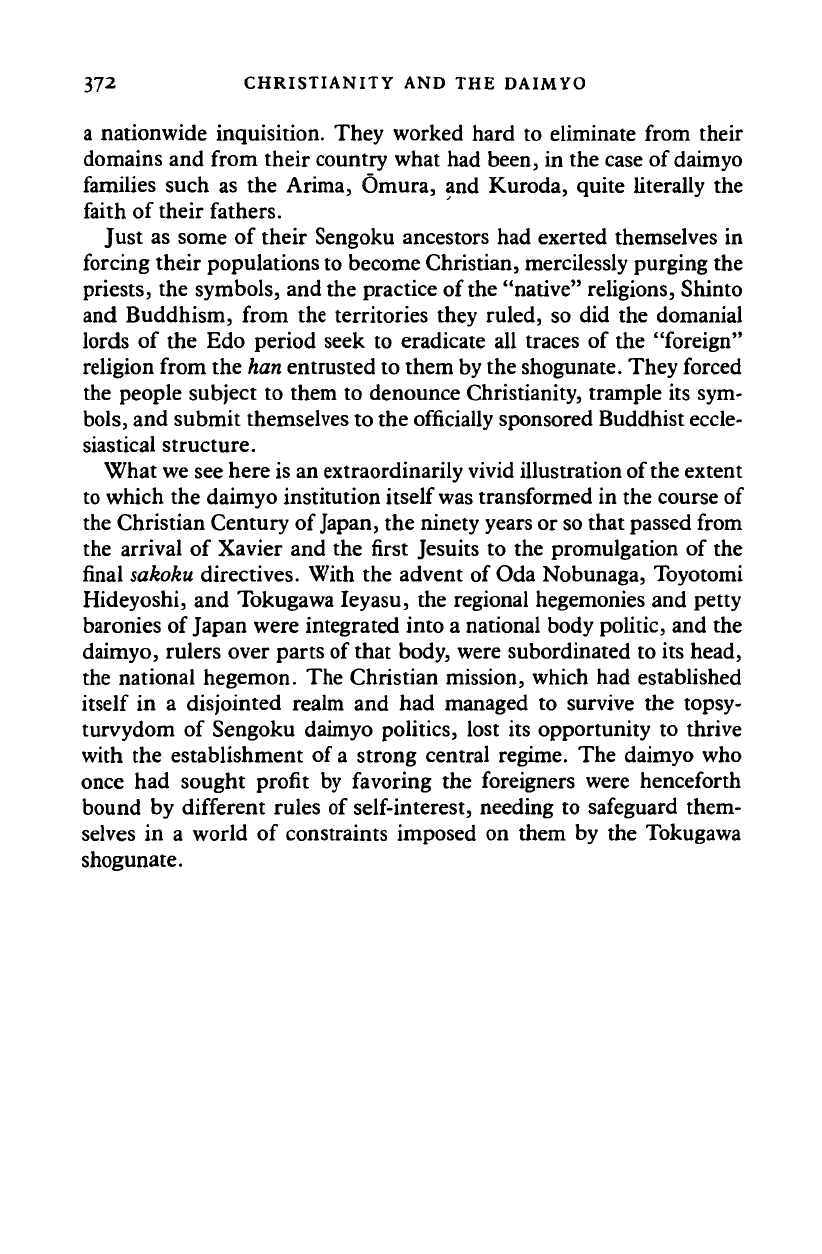
372 CHRISTIANITY AND THE DAIMYO
a nationwide inquisition. They worked hard to eliminate from their
domains and from their country what had been, in the case of daimyo
families such as the Arima, Omura, and Kuroda, quite literally the
faith of their fathers.
Just as some of their Sengoku ancestors had exerted themselves in
forcing their populations to become Christian, mercilessly purging the
priests, the symbols, and the practice of the "native" religions, Shinto
and Buddhism, from the territories they ruled, so did the domanial
lords of the Edo period seek to eradicate all traces of the "foreign"
religion from the
han
entrusted to them by the shogunate. They forced
the people subject to them to denounce Christianity, trample its sym-
bols,
and submit themselves to the officially sponsored Buddhist eccle-
siastical structure.
What we see here is an extraordinarily vivid illustration of the extent
to which the daimyo institution itself was transformed in the course of
the Christian Century of Japan, the ninety years or so that passed from
the arrival of Xavier and the first Jesuits to the promulgation of the
final sakoku directives. With the advent of Oda Nobunaga, Toyotomi
Hideyoshi, and Tokugawa Ieyasu, the regional hegemonies and petty
baronies of Japan were integrated into a national body politic, and the
daimyo, rulers over parts of that body, were subordinated to its head,
the national hegemon. The Christian mission, which had established
itself in a disjointed realm and had managed to survive the topsy-
turvydom of Sengoku daimyo politics, lost its opportunity to thrive
with the establishment of
a
strong central regime. The daimyo who
once had sought profit by favoring the foreigners were henceforth
bound by different rules of self-interest, needing to safeguard them-
selves in a world of constraints imposed on them by the Tokugawa
shogunate.
Cambridge Histories Online © Cambridge University Press, 2008
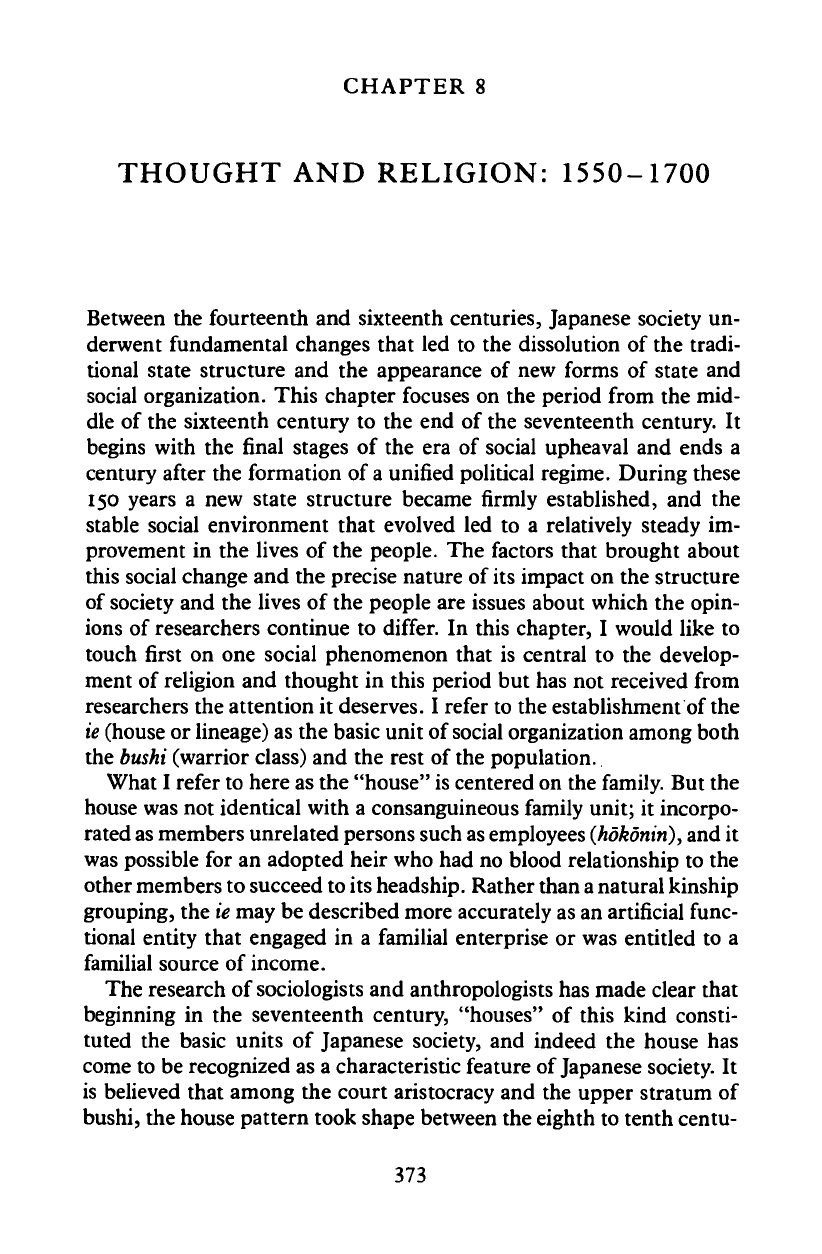
CHAPTER
8
THOUGHT AND RELIGION: 1550-1700
Between the fourteenth and sixteenth centuries, Japanese society un-
derwent fundamental changes that led to the dissolution of the tradi-
tional state structure and the appearance of new forms of state and
social organization. This chapter focuses on the period from the mid-
dle of the sixteenth century to the end of the seventeenth century. It
begins with the final stages of the era of social upheaval and ends a
century after the formation of
a
unified political regime. During these
150 years a new state structure became firmly established, and the
stable social environment that evolved led to a relatively steady im-
provement in the lives of the people. The factors that brought about
this social change and the precise nature of
its
impact on the structure
of society and the lives of the people are issues about which the opin-
ions of researchers continue to differ. In this chapter, I would like to
touch first on one social phenomenon that is central to the develop-
ment of religion and thought in this period but has not received from
researchers the attention it deserves. I refer to the establishment of the
ie
(house or lineage) as the basic unit of
social
organization among both
the
bushi
(warrior class) and the rest of the population.
What I refer to here as the "house" is centered on the family. But the
house was not identical with a consanguineous family unit; it incorpo-
rated
as
members unrelated persons such
as
employees
(hdkdnin),
and it
was possible for an adopted heir who had no blood relationship to the
other members to succeed
to
its
headship.
Rather than
a
natural kinship
grouping, the
ie
may be described more accurately as an artificial func-
tional entity that engaged in a familial enterprise or was entitled to a
familial source of income.
The research of sociologists and anthropologists has made clear that
beginning in the seventeenth century, "houses" of this kind consti-
tuted the basic units of Japanese society, and indeed the house has
come to be recognized as a characteristic feature of Japanese society. It
is believed that among the court aristocracy and the upper stratum of
bushi, the house pattern took shape between the eighth to tenth centu-
373
Cambridge Histories Online © Cambridge University Press, 2008
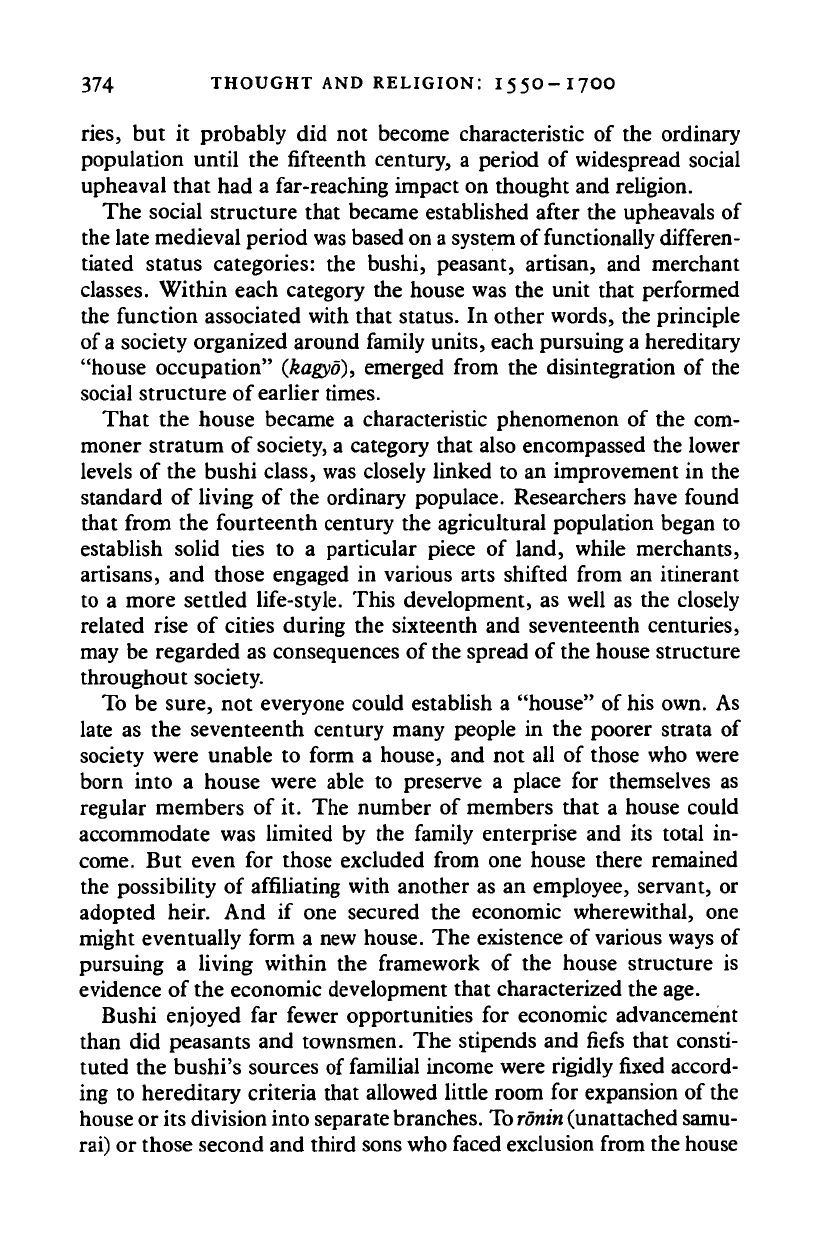
374 THOUGHT AND RELIGION: 155O-I7OO
ries,
but it probably did not become characteristic of the ordinary
population until the fifteenth century, a period of widespread social
upheaval that had a far-reaching impact on thought and religion.
The social structure that became established after the upheavals of
the late medieval period
was
based on
a
system of functionally differen-
tiated status categories: the bushi, peasant, artisan, and merchant
classes. Within each category the house was the unit that performed
the function associated with that status. In other words, the principle
of
a
society organized around family units, each pursuing a hereditary
"house occupation"
(kagyo),
emerged from the disintegration of the
social structure of earlier times.
That the house became a characteristic phenomenon of the com-
moner stratum of society, a category that also encompassed the lower
levels of the bushi class, was closely linked to an improvement in the
standard of living of the ordinary populace. Researchers have found
that from the fourteenth century the agricultural population began to
establish solid ties to a particular piece of land, while merchants,
artisans, and those engaged in various arts shifted from an itinerant
to a more settled life-style. This development, as well as the closely
related rise of cities during the sixteenth and seventeenth centuries,
may be regarded as consequences of the spread of the house structure
throughout society.
To be sure, not everyone could establish a "house" of his own. As
late as the seventeenth century many people in the poorer strata of
society were unable to form a house, and not all of those who were
born into a house were able to preserve a place for themselves as
regular members of it. The number of members that a house could
accommodate was limited by the family enterprise and its total in-
come. But even for those excluded from one house there remained
the possibility of affiliating with another as an employee, servant, or
adopted heir. And if one secured the economic wherewithal, one
might eventually form a new house. The existence of various ways of
pursuing a living within the framework of the house structure is
evidence of the economic development that characterized the age.
Bushi enjoyed far fewer opportunities for economic advancement
than did peasants and townsmen. The stipends and fiefs that consti-
tuted the bushi's sources of familial income were rigidly fixed accord-
ing to hereditary criteria that allowed little room for expansion of the
house or its division into separate branches.
To ronin
(unattached samu-
rai) or those second and third sons who faced exclusion from the house
Cambridge Histories Online © Cambridge University Press, 2008
